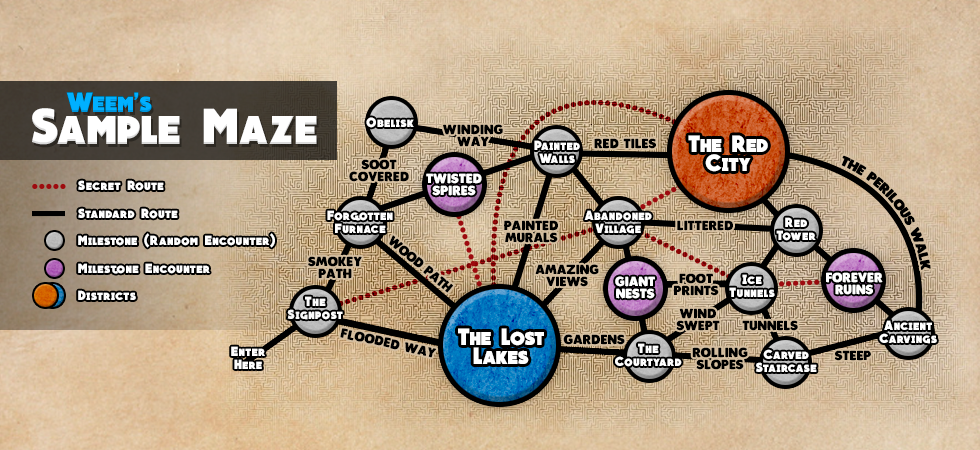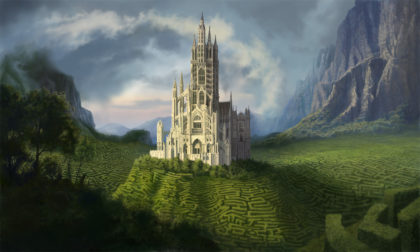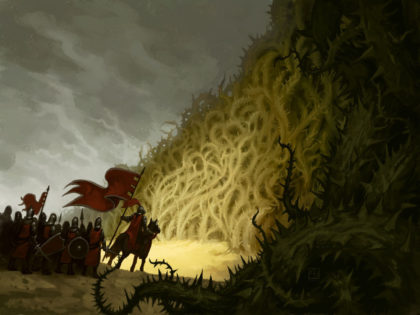Approaching Mazes as a DM can be a daunting task. I’ve seen a number of people ask about how to approach them on /r/dnd recently and it got me thinking… how would I do it? This article is about how I would approach maze design. It is not “The Right” way, or “The Only” way, it is simply a look at how I would approach it if I were working on one right now. I created the map below as an example, but I will refer to it from time to time as well as you continue…

Mapping as a Player… I Don’t Like It
I love to draw and sketch but I hate mapping as a player in D&D. Even if someone else is mapping, I don’t like it. It’s time consuming, and boring. If everything goes as planned, we players simply end up with the same map the DM has. When things do not go as planned, the reason why it didn’t is almost never fun in my opinion. For me, it seems one of two things have happened when we become lost…
There was a miscommunication between Player and DM at some point that the character in game would not likely have made, or
The DM is using things like shifting walls, which is fine, but in which case (at some point) I’m going question the reason for mapping. In these cases it seems the DM wants us to get lost as part of the “maze experience” and that makes mapping feel pointless.
Is It Possible to Become “Hopelessly” Lost?
For me, this is THE question when I consider making a maze. In this case it comes down to whether or not I want DEATH to be a very real possibility when becoming lost. The possibility of getting lost in a maze is essential to it really being a maze, otherwise it is just “the way”, but that is not the same as saying “Death from being lost is essential to a maze”.
I do not like the idea of death being a possible consequence of becoming lost. It is not interesting for me (as a DM) to have a TPK due to players becoming lost. And for both Players and DM, there would likely be a lot of (very boring) time spent leading up to the TPK while trying to become unlost.
Without death as a consequence of being lost, we are left with costs such as “time” and/or “resources”, which I prefer.
Time and/or Resources
If I am building a maze where Time and/or Resources are spent as a cost of becoming lost (or simply exploring), then those need to have importance in relation to the goal, or reason for navigating the maze. In other words, having more time and more resources needs to be a benefit or be a requirement of “completing” the maze (be it finding the exit, or otherwise).
That said, if food/water are a resource, AND getting lost spends resources, then we are essentially getting death as a possible outcome to being lost (which I again want to avoid).
It sounds good, and makes sense on paper, but in game it is (in my opinion) boring. Of course, it could be fine in a campaign set entirely in a maze, or a maze played by Players and DM who want that kind of game/management – it’s just not for me (or my players I think).
The Maze

With everything above taken into consideration, you will have a better understanding of how I came to the following approach. These are not steps for fully fleshing out an entire maze, but I wanted to show enough to get your mind thinking about how you might approach it as I would.
Important Elements
My approach to this is really not unlike approaching a dungeon design in some ways. There are some set piece areas I’ll call “Districts” with connected regions between them. These regions will be connected by joints called “Milestones” that you move between by making choices about where to go next.
The regions between Milestones and Districts will have varying lengths and difficulties, but some could even be hidden, in a sense. Let’s talk about all of these elements in a bit more detail.
Movement and Milestones
This is a maze, so there should be meaningful choices when it comes to “where to go” next. In fact, these meaningful choices are all I care about so I am highlighting them as Milestones. I am assuming the regions between them (when traveled) involve back-tracking, trying new ways, and getting (temporarily) lost, but I will abstract these things with various rolls. The success or failure of these will result in the cost of time and resources, but ultimately the idea is the party will eventually make it to the next Milestone or District.
I want Milestones to stand out from the general maze as points of interest. With that in mind, I will be naming and describing them. It also gives the players a nice point to refer back to. In fact, I will likely name most of the connecting regions as well, to help give them flavor and make them memorable.
Now you can imagine the players describing their choices as follows:
“Let’s backtrack to the Ice Tunnels and follow the Giant Footprints we have not yet explored,” instead of “Left… Right… Left… Left… Left…”.
Expending Resources

I will choose an amount of time it would take to move between each Milestone and District so I can measure that against Time and Resources spent. In this example, I may decide that each region takes 1, 2, 3, or 4 days to traverse if “all goes well”. I could indicate this on the map as well, but I did not.
Time
Determining whether or not things go well while traversing a region could be done a number of ways. I am not going to decide that as part of this article but some options for you include:
- Survival Checks – You could even give different regions different DC’s based on their difficulty as you determine it.
- Periodic Investigation Checks – As above essentially
- Mapper Aid – You could ask the Players to determine which Character is the mapper and then have that Player roll an INT check periodically. This could be combined with something above as an Aid roll. (Note, this is not actual player mapping, just a Player saying “My character will map this as we go” – a fluff expression for why they are rolling to provide aid in other words).
- Information Aid – Players could learn something at a Milestone or District that gives them Advantage on rolls related to specific regions and traversing them.
Resources
Again, for this example I am not using food or drink as a resource since I do not like that kind of survival requirement. That said, a loss of Resources as part of an abstraction of travel allows you to push the pace of the exploration. Resources could be lost on a per day basis, and/or over the course of an encounter could be destroyed if not protected.
Here are some quick examples of how Resources (and their loss) could work:
- Limited Resource Delivery – It could be that the Players have a specific and irreplaceable amount of a Resource that must be delivered, and losing some of it along the way (it spoils, is damaged, etc) can result in a loss or reduction of reward later.
- Resource Gathering – They could discover there is a rare resource in the maze that can be found (at the cost of time perhaps) but it also spoils (mushrooms, for example) that they know they can sell for great profit – perhaps in a District within the maze.
Districts and Denizens
Simply put, a District is an important area within the maze. It could be anything from a string of encounters (a temple for example) or even a huge city. As such, these places could be inhabited by a variety of creatures, or even the home to an entire race. The size of these will likely be determined by the overall scale of the maze, which I talk about next, but I consider these to be more than just one encounter (for which I would otherwise use a Milestone).
Scalability and Size
This kind of setup for a maze can be scaled to any size. Let’s take a look at how scale could affect the size of elements in the maze:
Large Scale
- District – City sized, or even more
- Milestones – Encounters or even multi-stage encounters (Temples, Caves, etc)
- Regions – These could take many days to traverse
Medium Scale
- District – Perhaps no larger than a small village, or large multi-stage encounter
- Milestones – Single encounter, or set piece to explore with a set or random encounter
- Regions – These may take hours or a few days to traverse (short of troubles during travel)
Small Scale
- District – These may simply be a set piece encounter
- Milestones – A small point of interest. Perhaps a Signpost or Obelisk
- Regions – These may only take hours to traverse (short of troubles during travel)
Extra Ideas and Inspiration
This was all just a look at how I would approach setting up a maze. It’s not a complete process because I just meant it to be a jumping off point for those looking for one. You may take it in a completely different direction, or it may make you think of something I have not mentioned.
As such, here are some other thoughts I’ve had during this process that might spark an idea or two…
- Getting to know the maze – Exploring the Milestones or Districts on either side of a region (which has also been traveled) could unlock some kind of benefit. For example, movement through that region could now less time than normal, or perhaps earn the players X number of resources when passing through it.
- Clues and information – I would consider recording a clue or piece of information that can be found in each Milestone and District that would give some benefit to the players while in another Milestone or District. For example you might note “There is a map of the ‘Abandoned Village’ (Milestone) here at the ‘Obelisk’ (Milestone)”.
- The Hunter – It might be cool to have a particularly dangerous creature in one region. You could even assign it a larger area by selecting a Milestone (for example) and knowing that it could be encountered in that Milestone or any region connected to it. This becomes even more interesting if the players learn about it and know it is a threat in a given area. It’s area could change as well, giving the maze a more dynamic threat.
- Visible Milestones and Districts – I like the idea of some Milestones and Districts being visible in the distance, so there is a sense of purpose in the direction players may choose to go. I don’t think it is required, I just like the idea of that.
Let’s Chat!
Hit me up on Twitter (@theweem) to chat about this, or anything really!